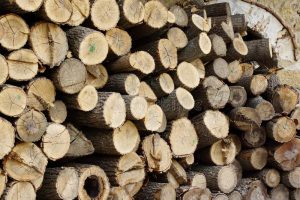Is Cottonwood Good for Firewood – Heat Output and Efficiency
For those who heat with wood, finding a tree that cuts easily, seasons quickly and burns clean is critical. If your wood lot offers a water source, you may have cottonwood trees on the property. Not only do these hardy trees offer terrific shade, but they also produce a low-odor fire when fully seasoned.

Is it Hard to Grow Cottonwood Trees?
Once they’re established, it can be hard not to grow cottonwood trees. If your region is prone to drought, you may have die-off if the creek or stream on your property dries up.
Cottonwood trees offer terrific shade, but they can get messy. There is a sap drip in the spring that can be hard on your vehicle finish if the cottonwood tree is close to your home. Because these trees produce fluffy cotton seedheads, there is also the risk that your AC units and house screens will fill up with cotton and need cleaning out. However, this is just a once-a-year problem and can be quickly managed.
Heat Output and Efficiency (in BTUs)
Cottonwood is not a high BTU wood; the grain is quite stringy when the wood is wet and as moisture leaves, the density drops quickly. You can expect to get no more than 16.8 million BTUs per cord of wood. That being said, these trees can grow up to 3 feet per year and in just ten years, you can have harvestable timber. Once you have a clump of cottonwood trees started, keeping them going will not be difficult.
Creosote Buildup
All woods generate creosote if burned green. Cottonwood, properly seasoned, burns hot and fast. You’ll end up with a lot of ash but not much creosote if you can give the wood plenty of seasoning time.
Amount of Smoke
Wet cottonwood firewood produces a lot of smoke that smells like cat urine. If you’re not sure if it’s ready to burn, split it. If it splits clean, it’s probably dry enough. If it splits stringy, give it more time.
Spark Production
When cottonwood is wet, the sparks can be dangerous. This is not the best wood for your open fireplace or a firepit on a windy night. Because seasoned cottonwood produces little odor, it’s a good base for a fire but if you love that fireplace aroma, you may want to mix this wood with pine.
Coal Production
Fully seasoned cottonwood is not a great coal producer. You’ll end up with much more ash than you will coal. If your goal is a slow-cooking fire, you may want to add hardwood.
How Long to Season Cottonwood Firewood?
Split cottonwood needs at least 6 months to season thoroughly. Once you’ve cut it into rounds, it may be safer and easier to split it after six months. Wet cottonwood is terribly stringy; your ax could end up swallowed in the round rather than splitting it.
Try to stack cottonwood off the ground and cover the top layer. Once you have it cut into rounds, let it cure for a few weeks before you try splitting it. Be prepared to leave your cottonwood out to season for at least a year if you leave it in rounds.
Is Cottonwood Firewood Expensive?
A cord of wood is 128 cubic feet. For seasoned hardwood, you can expect to pay up to $180 a cord, depending on where you live. Cottonwood may well be cheaper, but the price may be impacted by
- time it took to season the wood
- whether you need it split
- hauling and stacking
Because cottonwood is quick to grow, it may be less costly. If the woodsman has a woodlot that has running water, cottonwoods may spring up like weeds, lowering the price. However, the curing time of cottonwood should not be overlooked. If you’ve ever had to deal with the smoke and smell of a wet wood fire, you know that buying properly seasoned firewood is always a good deal. Oak will be more expensive and produce more heat, but cottonwood will likely be cheaper.
Timing will also impact what you pay for firewood. Everyone wants seasoned wood in the fall. If you can buy firewood in the spring and create a spot to let it cure, you may be able to get cottonwood for cheap, let it fully dry over the summer, and enjoy low-odor, low smoke fires all winter long. If you’re going to season your own firewood, you will need a spot where the sun can get to it and the wind can carry moisture away. Stacking your wet cottonwood against a building can rot your firewood. Make sure you’re also stacking the wood off the ground to avoid having that bottom row turn to compost.
Not only can buying locally in the spring get you decent wood at a low cost, but you can support local businesspeople and cut down on the number of pests that may be brought in by trucked wood.
Pros and Cons of Using Cottonwood for Firewood
If you love the smell of a campfire, cured cottonwood probably won’t work for you. Fully dried, there isn’t much odor to it and wet cottonwood produces a very nasty odor. Seasoned cottonwood burns hot and produces a decent amount of ash, so be prepared to clean out your stove or fireplace pretty regularly.
What To Do With Wood Ash
Wood ash from soft woods does not contain a lot of nutrients. That being said, you can compost wood ash to balance out the pH of your compost. If you choose to apply it directly to the soil, try to leave that area fallow for the first planting year so you can water the ash into the dirt. You can bump up the nutrients offered by wood ash by burning twigs and small branches to the fireplace or stove. New wood growth offers more nutrients.
Do check the pH of your soil before adding wood ash; some ash is extremely alkaline and may damage the soil. If you have a problem with snails or slugs anywhere in your garden, put down a border of wood ash to desiccate these pests before they get to your plants.
How Cottonwood Firewood Compares to Other Trees
A cottonwood fire made of cured wood will be low odor, burn fairly hot and generate a lot of ash. This is not the best wood to use if you need to bank your woodstove for a long, cold night. If you love to settle in beside your fireplace on a cold night and enjoy the intensity of a wood fire before bed, fully cured cottonwood will work fine.
If you don’t have an open spot where you can cure cottonwood, you probably want to buy another type of wood. Cottonwood can produce a lot of sparks when it’s wet and the odor can be really intense. Splitting your own cottonwood can actually take a great deal of time because you can’t split it when you cut it. Splitting rounds of firewood takes a decent amount of strength, a hearty ax and quite a bit of space.
Cottonwood is easy to source and can be seasoned to make a useful firewood. It doesn’t produce the hottest fire and it will need plenty of curing time, but if you have access to cottonwood trees, you can add this wood to your burning schedule.


